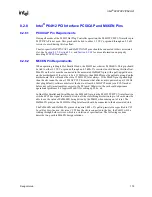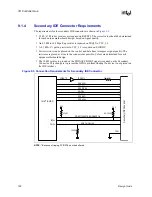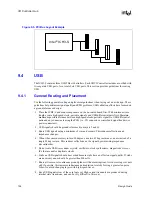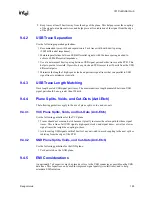
Design Guide
125
I/O Controller Hub
9. Keep traces at least 50 mils away from the edge of the plane. This helps prevent the coupling
of the signal onto adjacent wires, and helps prevent free radiation of the signal from the edge
of the PCB.
9.4.2
USB Trace Separation
Use the following separation guidelines.
•
Recommended trace width and separation is 5 mil trace width with 6 mil spacing
(90
Ω
differential impedance).
•
Maintain parallelism between USB differential signals, with the trace spacing needed to
achieve 90
Ω
differential impedance.
•
Use at a minimum 20 mil spacing between USB signal pair and other traces on the PCB. This
helps to prevent crosstalk. If possible, keep clock and PCI traces at least 50 mils from the USB
differential pairs.
•
Minimize the length of high-speed clock and periodic signal traces that run parallel to USB
signal lines to minimize crosstalk.
9.4.3
USB Trace Length Matching
Trace length match USB signal pair traces. The maximum trace length mismatch between USB
signal pair should be no greater than 150 mils.
9.4.4
Plane Splits, Voids, and Cut-Outs (Anti-Etch)
The following guidelines apply to the use of plane splits, voids, and cut-outs.
9.4.4.1
VCC Plane Splits, Voids, and Cut-Outs (Anti-Etch)
Use the following guidelines for the VCC plane:
•
Traces should not cross anti-etch because it greatly increases the return path for those signal
traces. This is true of all USB signals, high-speed clocks, and signal traces, as well as slower
signal traces that might be coupling to them.
•
Avoid routing USB signals within 50 mils of any anti-etch to avoid coupling to the next split or
radiating from the edge of the PCB.
9.4.4.2
GND Plane Splits, Voids, and Cut-Outs (Anti-Etch)
Use the following guideline for the GND plane:
•
Void anti-etch on the GND plane.
9.4.5
EMI Considerations
An optional 47 pF capacitor may be placed as close to the USB connector as possible on the USB
data lines. This capacitor can be used for improved signal quality (rise/fall time), and to help
minimize EMI radiation.
Summary of Contents for Xeon
Page 24: ...Introduction 24 Design Guide This page is intentionally left blank ...
Page 30: ...Component Quadrant Layout 30 Design Guide This page is intentionally left blank ...
Page 52: ...Platform Clock Routing Guidelines 52 Design Guide This page is intentionally left blank ...
Page 66: ...System Bus Routing Guidelines 66 Design Guide This page is intentionally left blank ...
Page 118: ...Intel 82870P2 P64H2 118 Design Guide This page is intentionally left blank ...
Page 146: ...I O Controller Hub 146 Design Guide This page is intentionally left blank ...
Page 148: ...Debug Port 148 Design Guide This page is intentionally left blank ...
Page 210: ...Schematic Checklist 210 Design Guide This page is intentionally left blank ...
Page 220: ...Layout Checklist 220 Design Guide This page is intentionally left blank ...
Page 222: ...Schematics 222 Design Guide This page is intentionally left blank ...















































